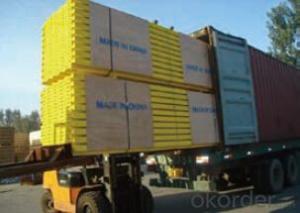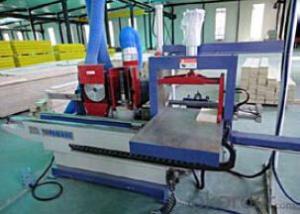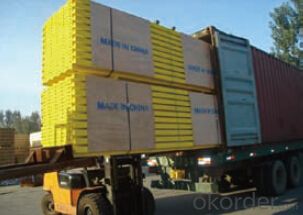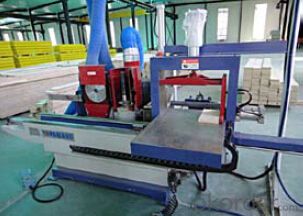Timber Beam H20 for formwork and scaffolding systems
- Loading Port:
- Tianjin
- Payment Terms:
- TT OR LC
- Min Order Qty:
- 50 m²
- Supply Capability:
- 1000 m²/month
OKorder Service Pledge
OKorder Financial Service
You Might Also Like
Characteristics:
◆ Standardized production lines.
Supply capability: 3000m/day, Lmax = 6600mm.
◆ Finger jointing of the flange and web, the strength of timber beam is highly improved.
Max. shearing force failure load:40KN
◆ Well treated to prevent from water penetration or erosion, so the service life maximally extended.
Normally, CNBM timber beam H20 can be used for 4 to 5 years, the exact using time would depend on maintenance & storage.
◆ Robust caps at the end of the girders protect against damages.
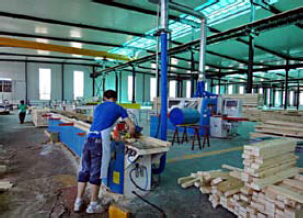
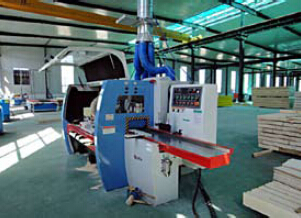
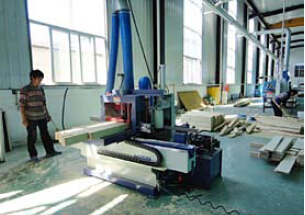
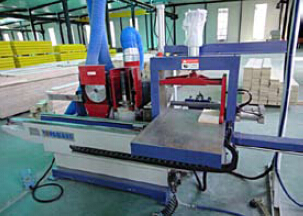
- Q: What are the different types of form ties used in steel formwork?
- There are several different types of form ties used in steel formwork, each designed to serve a specific purpose and meet specific requirements. 1. Coil Ties: These ties consist of a coil rod with two to four coils, which provide flexibility and allow for easy installation and removal. Coil ties are commonly used in lighter applications where relatively low pressure is expected. 2. Flat Ties: Flat ties are typically made of steel and have flat, wide plates on both ends. They are used to connect opposite wall forms, providing stability and preventing the forms from bulging or spreading due to the pressure of the concrete. 3. She-Bolt Ties: She-bolt ties consist of a threaded rod with a she-bolt attached to one end. These ties are used to secure wall forms together, and the threaded rod allows for easy adjustment of the formwork. 4. Snap Ties: Snap ties are a popular choice for fast and efficient formwork installation. They consist of a metal rod with a button-like head on one end and a wedge on the other. The button head is inserted into the formwork, and the wedge is then driven into the button head using a hammer, creating a strong connection. 5. Cone Ties: Cone ties are similar to snap ties, but they have a cone-shaped head instead of a button head. The cone head is inserted into the formwork, and a metal wedge is driven into the cone, securing the formwork. 6. Waler Ties: Waler ties are used to connect horizontal waler beams with vertical formwork members. They provide additional strength and stability to the formwork system. 7. Loop Ties: Loop ties are made of steel wire and have loops on both ends. They are used to secure wall forms together and can be easily removed once the concrete has cured. 8. Pin and Wedge Ties: Pin and wedge ties consist of a pin and a wedge. The pin is inserted into the formwork, and the wedge is driven into the pin, creating a tight and secure connection. These are just a few examples of the different types of form ties used in steel formwork. The choice of tie will depend on factors such as the type of construction, desired strength, ease of installation, and specific project requirements.
- Q: What is the standard thickness of steel formwork
- Opposite? The negative is not too clear. Generally if there is pellicle
- Q: Can steel formwork be used for fire-resistant concrete structures?
- No, steel formwork cannot be used for fire-resistant concrete structures. Steel is highly susceptible to heat and can lose its structural integrity when exposed to high temperatures, thus compromising the fire resistance of the concrete structure. Fire-resistant concrete structures require specialized forms made of non-combustible materials, such as fire-rated plywood or fiber-reinforced plastic, which can withstand extreme heat and maintain the integrity of the structure during a fire.
- Q: Can steel formwork be used for projects with limited formwork assembly time?
- Yes, steel formwork can be used for projects with limited formwork assembly time. Steel formwork is known for its durability and strength, making it a suitable choice for projects that require quick assembly and demobilization. Unlike traditional timber formwork, steel formwork can be easily assembled and dismantled, reducing the overall construction time. Additionally, steel formwork is reusable, allowing for cost savings and increased efficiency on future projects. Overall, steel formwork is a reliable solution for projects with limited formwork assembly time.
- Q: How does steel formwork contribute to the efficiency of construction processes?
- Steel formwork contributes to the efficiency of construction processes by providing a durable and reusable framework for casting concrete structures. Its strength and rigidity allow for faster construction progress, as it can withstand the pressure exerted by wet concrete, resulting in shorter construction cycles. Additionally, steel formwork allows for precise and accurate shaping of concrete elements, ensuring the desired dimensions and quality of the final product. Its reusability minimizes waste, reduces costs, and promotes sustainability in construction projects.
- Q: Can steel formwork be used for industrial construction projects?
- Yes, steel formwork can be used for industrial construction projects. Steel formwork offers several advantages such as durability, strength, and reusability, making it suitable for heavy-duty applications in industrial construction. It provides a stable and rigid structure to support concrete during the casting process, ensuring accurate and high-quality results. Additionally, steel formwork can withstand harsh weather conditions and repetitive use, making it ideal for industrial projects that require long-term and reliable formwork systems.
- Q: How does steel formwork affect the cost of construction?
- Steel formwork can have a significant impact on the overall cost of construction. While it may require a higher initial investment compared to traditional formwork materials such as wood or plywood, steel formwork offers several advantages that can help offset the increased cost. Firstly, steel formwork is incredibly durable and long-lasting, which means it can be reused multiple times. Unlike wood or plywood formwork, steel formwork does not warp, rot, or degrade over time. This reusability factor reduces the need for frequent formwork replacements, thus saving on material costs in the long run. Additionally, steel formwork provides superior strength and stability, allowing for the construction of complex and high-quality concrete structures. This strength enables the use of thinner formwork elements, reducing the overall weight of the formwork system. As a result, less labor and equipment are required for handling and installation, leading to cost savings in terms of manpower and machinery. Furthermore, steel formwork allows for faster construction cycles. The smooth and precise surface finish provided by steel formwork reduces the need for extensive finishing work. This streamlined construction process saves time, ultimately reducing labor costs and project timelines. Moreover, steel formwork offers enhanced safety on construction sites. Its sturdy nature and secure connections ensure stability during concrete pouring and curing, minimizing the risk of accidents or structural failures. This improved safety aspect can help in reducing insurance costs and potential legal liabilities. Lastly, steel formwork is highly adaptable and customizable. It can be easily modified and adjusted to accommodate various design requirements, making it suitable for a wide range of construction projects. This flexibility helps optimize material usage and ensures minimal wastage, thereby reducing overall construction costs. In summary, although steel formwork may initially incur a higher cost, its long-term benefits such as reusability, strength, speed, safety, and adaptability contribute to overall cost savings in construction projects. Its durability and efficiency make it a cost-effective choice that can positively impact the quality, timeline, and budget of any construction undertaking.
- Q: How does steel formwork impact the overall project scheduling?
- Steel formwork can have a significant impact on the overall project scheduling. One of the main advantages of using steel formwork is its ability to provide a faster construction process compared to traditional timber formwork. Steel formwork is known for its durability and strength, allowing for multiple reuses without compromising the quality of the concrete structure. This reusability reduces the time required for formwork installation and removal, leading to faster construction progress. Additionally, steel formwork provides a higher level of accuracy and precision in achieving desired shapes and dimensions for the concrete structure. This accuracy minimizes the need for rework and adjustments, which can save considerable time during the construction process. Furthermore, steel formwork systems are easily adjustable and adaptable, allowing for quick changes and modifications to the formwork design, if necessary. This flexibility can help to avoid delays caused by design modifications. Moreover, steel formwork is usually prefabricated off-site, meaning that it can be delivered to the construction site ready to be assembled. This off-site fabrication reduces the time required for on-site assembly, as well as the need for skilled labor and equipment. The faster installation and assembly of steel formwork contribute to overall time savings and improved project scheduling. However, it is important to note that the impact of steel formwork on project scheduling can also depend on various factors, such as the complexity of the structure, the size of the project, and the availability of skilled labor. It is crucial to carefully plan and coordinate the use of steel formwork to ensure its optimal utilization and maximize the benefits it brings to the overall project scheduling.
- Q: How does steel formwork handle different concrete surface gloss levels?
- Steel formwork is an excellent choice for handling different concrete surface gloss levels due to its versatility and durability. The smooth and rigid nature of steel formwork allows it to create a consistent and even surface finish, regardless of the gloss level desired. When it comes to different concrete surface gloss levels, steel formwork offers several advantages. Firstly, it provides a smooth and uniform surface, which is crucial for achieving a high gloss finish. The steel panels are precisely constructed to create a seamless surface, minimizing any irregularities that could affect the gloss level. Additionally, steel formwork is highly resistant to warping or bending under the weight of the concrete, ensuring that the surface remains level and consistent. This is particularly important when aiming for a glossy finish, as any inconsistencies in the formwork could result in uneven concrete placement and subsequent variations in gloss. Furthermore, steel formwork is reusable, making it cost-effective and environmentally friendly. With proper maintenance and care, steel formwork can be used for multiple projects, allowing for consistent results in terms of gloss levels. In conclusion, steel formwork is an ideal choice for handling different concrete surface gloss levels. Its smooth and rigid construction ensures a uniform surface finish, while its durability guarantees consistent results. Steel formwork provides an efficient and effective solution for achieving various gloss levels in concrete construction projects.
- Q: Are there any safety precautions to consider when using steel formwork?
- When using steel formwork, it is important to consider several safety precautions. 1. Proper training is crucial. Workers must receive training on correct handling and assembly procedures. This includes understanding load capacity, installation techniques, and dismantling processes. 2. Regular inspection and maintenance are necessary to ensure the formwork's structural integrity. Any signs of damage should be immediately addressed and repaired. 3. Workers should wear appropriate personal protective equipment (PPE), such as helmets, safety goggles, gloves, and steel-toe boots. This protects them from potential hazards. 4. A secure and stable platform is essential for workers to access and work on the formwork. This may involve using scaffolding, ladders, or elevated work platforms that meet safety standards. 5. Fall protection measures must be implemented for working at heights. This may include installing guardrails, safety nets, or personal fall arrest systems. 6. Proper lifting techniques should be followed to prevent strain or muscle injuries. Mechanical lifting equipment can also help minimize accidents. 7. Clear communication and coordination among workers is vital. This includes establishing a chain of command, using hand signals or radios, and conducting regular safety meetings. By following these precautions, the risk of accidents, injuries, and damage can be significantly reduced when using steel formwork.
Send your message to us
Timber Beam H20 for formwork and scaffolding systems
- Loading Port:
- Tianjin
- Payment Terms:
- TT OR LC
- Min Order Qty:
- 50 m²
- Supply Capability:
- 1000 m²/month
OKorder Service Pledge
OKorder Financial Service
Similar products
Hot products
Hot Searches
Related keywords
